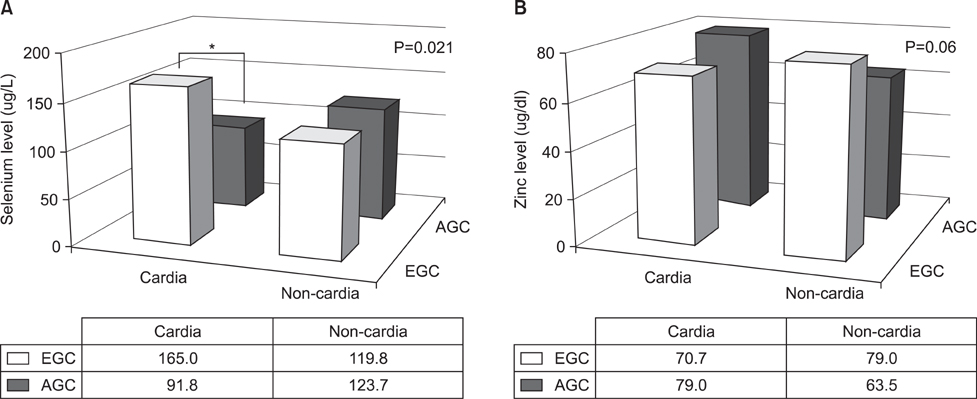J Gastric Cancer.
2012 Dec;12(4):217-222.
Clinical Correlation between Gastric Cancer Type and Serum Selenium and Zinc Levels
- Affiliations
-
- 1Department of Surgery, Seoul Medical Center, Seoul, Korea. shindonggue@naver.com
Abstract
- PURPOSE
We conducted this study to study the clinical correlation between the characteristics of gastric cancer and serum selenium and zinc levels.
MATERIALS AND METHODS
The following data were measured in the baseline serum selenium and zinc levels of 74 patients with curative gastrectomy subsequent to confirmed gastric cancer, from March 2005 to August 2012.
RESULTS
Among the 74 gastric cancer patients, 53 patients were male. Mean serum selenium and zinc levels were 118.7+/-33.1 ug/L and 72.2+/-24.3 ug/dl, respectively. Seven patients (9.5%) showed lower selenium level, and 33 patients (44.6%) showed lower zinc level. Serum Selenium level was 99.1+/-31.8 ug/L in cardia cancer group (10 cases) and 121.8+/-32.4 ug/L in non-cardia cancer group (64 cases)(P=0.044). According to tumor gross type, zinc level was 78.7+/-29.6 ug/dl in early gastric cancer (33) and 66.9+/-17.8 ug/dl in advanced gastric cancer (41) (P=0.064).
CONCLUSIONS
The serum selenium level was highly correlated with the location of gastric cancer. The serum zinc level was lower in advanced gastric cancer.
Keyword
Figure
Reference
-
1. Zeng H, Combs GF Jr. Selenium as an anticancer nutrient: roles in cell proliferation and tumor cell invasion. J Nutr Biochem. 2008. 19:1–7.
Article2. Combs GF Jr. Current evidence and research needs to support a health claim for selenium and cancer prevention. J Nutr. 2005. 135:343–347.
Article3. Biesalski HK, Grimm P. Pocket Atlas of Nutrition. 2005. 3rd ed. Stuttgart: Georg Thieme Verlag.4. Rotruck JT, Pope AL, Ganther HE, Swanson AB, Hafeman DG, Hoekstra WG. Selenium: biochemical role as a component of glutathione peroxidase. Science. 1973. 179:588–590.
Article5. Rayman MP. The importance of selenium to human health. Lancet. 2000. 356:233–241.
Article6. Moghadaszadeh B, Beggs AH. Selenoproteins and their impact on human health through diverse physiological pathways. Physiology (Bethesda). 2006. 21:307–315.
Article7. Fukuzawa K. Kondo M, editor. Biological defense systems in oxygen stress and new antioxidant drugs based on these systems. Free Radicals in Clinical Medicine. 1988. Vol. 3. Tokyo: Nihon-Igakukan.8. Navarro Silvera SA, Rohan TE. Trace elements and cancer risk: a review of the epidemiologic evidence. Cancer Causes Control. 2007. 18:7–27.
Article9. Kabuto M, Imai H, Yonezawa C, Neriishi K, Akiba S, Kato H, et al. Prediagnostic serum selenium and zinc levels and subsequent risk of lung and stomach cancer in Japan. Cancer Epidemiol Biomarkers Prev. 1994. 3:465–469.10. Birt DF. Update on the effects of vitamins A, C, and E and selenium on carcinogenesis. Proc Soc Exp Biol Med. 1986. 183:311–320.
Article11. Ip C, Hayes C, Budnick RM, Ganther HE. Chemical form of selenium, critical metabolites, and cancer prevention. Cancer Res. 1991. 51:595–600.12. Shamberger RJ, Tytko SA, Willis CE. Antioxidants and cancer. Part VI. Selenium and age-adjusted human cancer mortality. Arch Environ Health. 1976. 31:231–235.13. Atukorala S, Basu TK, Dickerson JW, Donaldson D, Sakula A. Vitamin A, zinc and lung cancer. Br J Cancer. 1979. 40:927–931.
Article14. Prasad AS. Clinical, biochemical and nutritional spectrum of zinc deficiency in human subjects: an update. Nutr Rev. 1983. 41:197–208.
Article15. Morris JS, Stampfer MJ, Willett WC. Dietary selenium in humans toenails as an indicator. Biol Trace Elem Res. 1983. 5:529–537.
Article16. Longnecker MP, Stram DO, Taylor PR, Levander OA, Howe M, Veillon C, et al. Use of selenium concentration in whole blood, serum, toenails, or urine as a surrogate measure of selenium intake. Epidemiology. 1996. 7:384–390.
Article17. Rhee JK, Chung JH, Sakong J, Kang PS, Kim CY, Lee KS. Association between cancer and selenium concentration in blood and toenails. Yeungnam Univ J Med. 1992. 9:29–43.
Article18. Song SH, Song K, Lee SB, Kim CS. The serum selenium level in Korean men and its association with age and prostate cancer. Korean J Urol. 2006. 47:150–153.
Article19. Mark SD, Qiao YL, Dawsey SM, Wu YP, Katki H, Gunter EW, et al. Prospective study of serum selenium levels and incident esophageal and gastric cancers. J Natl Cancer Inst. 2000. 92:1753–1763.
Article20. Fernandez-Madrid F, Prasad AS, Oberleas D. Effect of zinc deficiency on nucleic acids, collagen, and noncollagenous protein of the connective tissue. J Lab Clin Med. 1973. 82:951–961.21. Mclean AE, Ahmed K, Judah JD. Cellular permeability and the reaction to injury. Ann N Y Acad Sci. 1964. 116:986–989.
Article
- Full Text Links
- Actions
-
Cited
- CITED
-
- Close
- Share
- Similar articles
-
- Assessment of selenium and zinc status in female collegiate athletes
- Effect of the Interaction Between Selenium and Zinc on DNA Repair in Association With Cancer Prevention
- Association between Serum Zinc Levels and T-Cell Subsets in Patients with Lung Cancer
- The Serum Selenium Level in Korean Men and Its Association with Age and Prostate Cancer
- Risk Factors for Vitamin D, Zinc, and Selenium Deficiencies in Korean Patients with Inflammatory Bowel Disease


